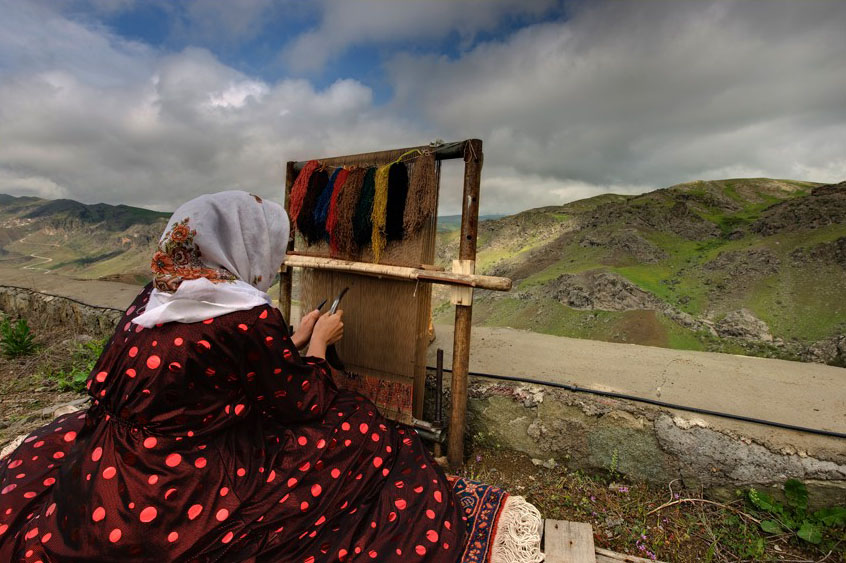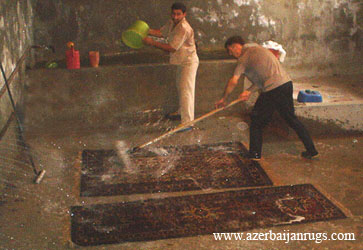
 |
|
|

Weaving and Finishing Steps
|
|
The first step is to prepare the sketch of a desired rug design. The sketch is a full-size paper drawing that is squared and each square representing one knot of a particular colour. The weaver places this upon the loom and translates the design directly. |
|
|
Next step is to string the loom with the warp material. This is done with one long string, which is wrapped continuously around the upper and lower beams of the loom. The three most common materials used here are wool, cotton or silk depending on the type of the woven rug. Most Azerbaijan rugs have wool warps. These warp cords form the skeleton of the rug, the base upon which the knots are tied.
|
 |
The weaving is started from the bottom of the loom. First the kilim part
(flat woven part) is woven at the lower edge. The weaver takes a piece of
wool or silk to form a knot on two warps corresponding with the designs and
colors in the picture. Then she cuts the surplus wool with a hooked knife. After one row of knotting is completed, the weaver passes one or several weft threads (according to the type of rug) in between the front and back warps. The weft threads are used to strengthen the weaves of the carpet. Then she takes the "kirkit" (a heavy comb like tool) and vigorously beat down the row of knots and weft, in order to obtain the desired tightness and to make the knots and weft compact.
|
 |
Following this step, with a pair of adjustable scissors she
cuts the surplus colored threads to obtain a uniform level of pile
thickness. These processes continue until the carpet is completed.
|
 |
A carpet measuring 150 x 250 cm (approx. 5 by 8 feet) can have up to 1 million knots (Shirvan and Kuba types) and represents about 100-120 days of weaving (two weavers). This does not include shearing, washing, sorting, carding, spinning and dyeing the wool, set-up time, fringe weaving and the final washing and drying. "Antique rugs of the Future" project affected family life in the weaving villages of Baku, Kazak, Kuba and Shirvan regions by enabling the weavers to continue productive work at home. Beside our workshop, we work with the local women who fit weaving in with their household chores, which improves their social and economic status. Working on a loom that,
typically, is a major feature of a single room containing a wood stove,
kitchen utensils and a stack of sleeping mats, a weaver can tie about 5000
knots in an uninterrupted eight-hour day. During the weaving season she may
make about five carpets. |
 |
The entire rug is washed to remove all remaining dirt and yarn particles. The rug is laid flat on the ground, then fresh water is poured over it. The rug washers then use a wood plank to force the water through the rug pile. This removes impurities picked up during the weaving process.
|
 |
The rug then is kept in a special drying room until it is completely dry. |
 |
The last step is to stretch the finished rug. The rug is stretched over the wooden panels to flatten the wrinkles and to ensure the rug lays properly on the floor. |
Copyright © Azerbaijan Rugs 2004-2019
E-mail:
vd@azerbaijanrugs.com
E-mail:
ra@azerbaijanrugs.com
Tel: +994 50 380 88 78
(Baku, Azerbaijan)
Tel: 415.690.7735 (San Francisco, USA)